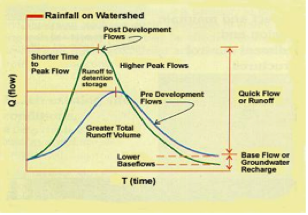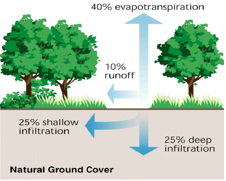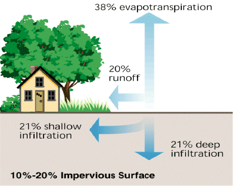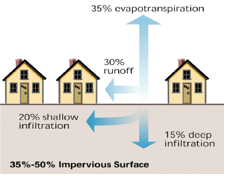Stormwater issues are closely related to the amount of impervious surface in the watershed. Therefore stormwater issues are associated with broad land use categories for instance residential, commercial, or industrial. In the Huron Creek Watershed, the rainwater from these surfaces is quickly released into the creek without pre-treatment. When the rate at which stormwater is released is not managed, the flow can enter the stream at much higher velocities and temperature that would naturally flow. This “flash” of water can alter stream banks, riparian vegetation, and stream channel shape. Stormwater is usually at higher temperatures therefore this can result in damages to aquatic species.

http://www.env.gov.bc.ca/wat/wq/nps/NPS_Pollution/Stormwater_Runoff/SW_Main.htm )
Secondly, stormwater transports sediment and pollution into the stream, which can adversely affect the health. According to the EPA, “sediments and soils constitute the largest volume of pollutant loads to receiving waters in urban areas” (EPA, 1996). These pollutants accumulate from impervious areas, construction sites, and residential lawns, these then enter the creek with the initial runoff (first flush). Stormwater contaminants include “oil, grease, and toxic chemicals from automobiles; nutrients and pesticides; road salts; and heavy metals.” (EPA, 1996).
The Huron Creek Watershed has large amounts of impervious surface, road sediments, and increased flow due to spring melt. As more impervious surface is created, the amount of water running off these surfaces and into local water systems also greatly increases. According to the EPA, a typical city block generates nine times more runoff than a natural woodland area of the same size. Furthermore, the Michigan DNR has found that “higher runoff correlates to decreased groundwater recharge, decreased base flow, increased and flashier stream flow, increases in temperature, turbidity, pollutants, erosion, and changes in aquatic biota (Premo et al. 2001). Experts now consider a watershed that has 11%-25% impervious surface as “impacted”, while areas that have more that 25% impervious surfaces are considered degraded (Premo et al. 2001).
 |
 |
 |
(photos courtesy of http://www.fairfaxcounty.gov/parks/accotink/impervious.htm )
The Huron Creek Watershed currently has 13.6% impervious surface, which deems it as impacted by the United States Environmental Protection Agency.
References
Environmental Protection Agency (EPA). 1996. Managing Urban Runoff . Pointer No. 7, EPA841-F-96_004G.
Premo, B.J., D.T. Long, R.J. Huggett, D. Premo, W.W. Taylor, G.T. Wolff and K.G. Harrison. 2001. Recommended Environmental Indicators Program for the State of Michigan , July 2001. Michigan Environmental Science Board, Lansing.